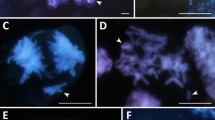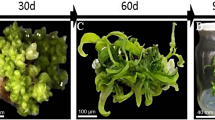Abstract
Cytological observations on the endosperm ofZephyranthes grandiflora have shown that the endosperm is triploid in general, with 3n=36 chromosomes, but that nuclei of higher polyploidy also occur.
Wall formation started at 7 days after pollination and the 9 day old endosperm was completely cellular. Maximum variation in size and shape of nuclei was recorded in the 8 day old endosperm. No, similar variation was observed in the root tip nuclei. Polyploidy by endomitosis, and probably also by fusion of nuclei, together with aneuploidy may be responsible for the nuclear variation in the endosperm.
The low seed setting has been attributed to the failure of endosperm resulting from the mitotic irregularities which characterized the collapsing endosperm.
Similar content being viewed by others

References
Bailey, L. H. (1949). Manual of cultivated plants. New York, Macmillan & Co.
Beaudry, J. R. (1951). Seed development following the matingElymus virginicus×Agropyron repens (L) Beauv.Genetics 36: 109–133.
Bhaduri, P. N. &P. N. Bose (1947). Cytological investigations in some common cucurbits, with a special reference to fragmentation of chromosomes as physical basis of speciation.J. Genet. 48: 237–256.
Bhaduri, P. N. &A. K. Kar (1948). Study of chromosome nucleolus relationship and its bearing on the interpretation ofOenothera cytogenetics.Bull. Bot. Soc. Bengal 2: 1–14.
Bhatia, G. S. (1938). The cytology of some Indian wheats.Ann. Bot. N.S. 2: 335–371.
Original not Seen.Bold, H. C. &A. Gershoy (1934). Studies in North American violets. IV. Chromosome relations and fertility in diploid and tetraploid species.Vermont Agric. Exp. Sta. Bull. 378: 1–65.
Boyes, J. W. &W. P. Thompson (1937). The development of the endosperm and embryo in reciprocal interspecific crosses in cereals.J. Genet. 34: 203–227.
Brink, R. A. &D. C. Cooper (1947). The endosperm in seed development.Bot. Rev. 13: 423–541.
Brock, R. D. (1954a). Spontaneous chromosome breakage inLilium endosperm.Ann. Bot. N.S. 18: 7–14.
Brock, R. D. (1954b). Fertility inLilium hybrids.Heredity 8: 409–420.
Brock, R. D. (1955). Chromosome balance and endosperm failure in hyacinths.Heredity 9: 119–222.
Coe, G. E. (1954). Chromosome numbers and Morphology inHabranthus andZephyranthes.Bull. Torrey bot. Cl. 81: 141–148.
Darlington, C. D. &P. T. Thomas (1937). The breakdown of cell division in aFestuca-Lolium derivative.Ann. Bot. N.S. 1: 747–762.
Fankhauser, G. (1945). The effect of changes in chromosome number on amphibian development.Quart. Rev. Biol. 20: 20–78.
Geitler, L. (1948). Notizen zur endomitotischen Polyploidisierung in Trichocyten und Elaiosomen sowie über Kernstrukturen beiGagea lutea.Chromosoma 3: 271–281.
Johansen, E. &B. W. Smith (1956).Arachis hypogaea × A diogoi. Embryo and seed failure.Amer. J. Bot. 43: 250–258.
Kapoor, B. M. (1963). Cytology of endosperm of some Angiosperms. Ph. D. Thesis. University of Delhi, India.
Original not seen.Li, W. H. &D. S. Tu (1947). Studies on the chromosomal aberrations of amphidiploids,Triticum timopheevi andAegilops bicornis.Bot. Bull. Acad. Sinica 1: 173–186.
Pathak, G. N. (1940). Studies on the cytology ofCrocus.Ann. Bot. N.S. 4: 227–256.
Punnett, H. H. (1953). Cytological evidence of hexaploid cells in maize endosperm.J. Hered. 44: 257–259.
Original not seen.Reusch, J. D. H. (1959). Embryological studies in seed development in reciprocal crosses betweenLolium perenne andFestuca pratensis. S. Afri. J. agric. Sci.2: 429–49.
Roy, R. P. &J. Saran (1960a). Endosperm cytology.Proc. 47th Indian Sci. Congr. (Bombay), PartIII: 363–364.
Roy, R. P. &J. Saran (1960b). Endosperm failure inMedicago sativa L.Proc. 47th Indian Sci. Congr. (Bombay), PartIII: 354.
Sharma, A. K. (1956). A new concept of a means of speciation in plants.Caryologia 9: 93–130.
Straus, J. (1954). Maize endosperm tissue grownin vitro. II. Morphology and Cytology.Amer. J. Bot. 41: 833–839.
Tandon, S. L. &B. M. Kapoor (1961). Nucleolar number and polyploidy level.Curr. Sci. 30: 476–477.
Tandon, S. L. &B. M. Kapoor (1962a). Cytology of endosperm in Angiosperms.Sci. and Cult. 28: 114–117.
Tandon, S. L. &B. M. Kapoor (1962b). Contributions to the cytology of endosperm in some Angiosperms-I.Zephyranthes ajax Sprenger.Caryologia 15: 21–41.
Tandon, S. L. &B. M. Kapoor (1963). Contributions to the cytology of endosperm in some Angiosperms-II.Nothoscordum fragrans Kunth.Caryologia, (in press).
Author information
Authors and Affiliations
Rights and permissions
About this article
Cite this article
Kapoor, B.M., Tandon, S.L. Contributions to the cytology of endosperm in some angiosperms. Genetica 34, 102–112 (1964). https://doi.org/10.1007/BF01664183
Received:
Issue Date:
DOI: https://doi.org/10.1007/BF01664183



